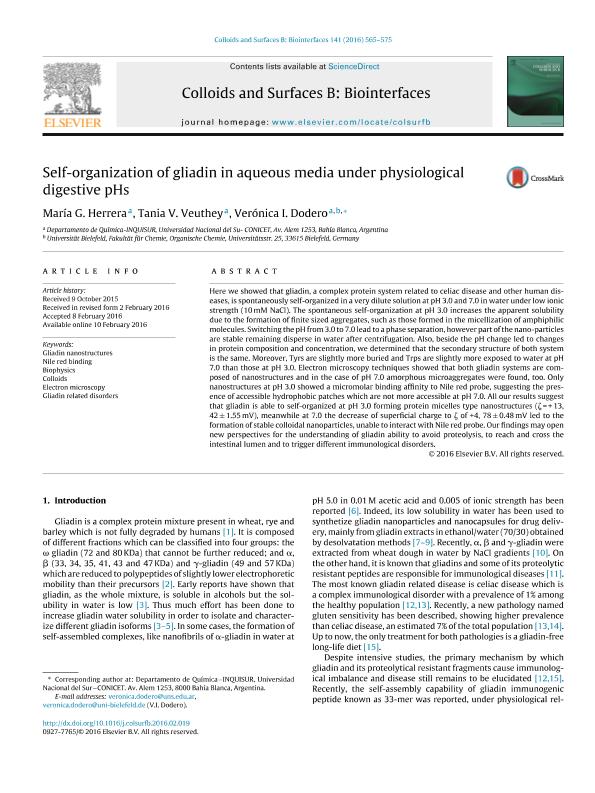Artículo
Self-organization of gliadin in aqueous media under physiological digestive pHs
Fecha de publicación:
05/2016
Editorial:
Elsevier Science
Revista:
Colloids and Surfaces B: Biointerfaces
ISSN:
0927-7765
Idioma:
Inglés
Tipo de recurso:
Artículo publicado
Clasificación temática:
Resumen
Here we showed that gliadin, a complex protein system related to celiac disease and other human diseases, is spontaneously self-organized in a very dilute solution at pH 3.0 and 7.0 in water under low ionic strength (10 mM NaCl). The spontaneous self-organization at pH 3.0 increases the apparent solubility due to the formation of finite sized aggregates, such as those formed in the micellization of amphiphilic molecules. Switching the pH from 3.0 to 7.0 lead to a phase separation, however part of the nano-particles are stable remaining disperse in water after centrifugation. Also, beside the pH change led to changes in protein composition and concentration, we determined that the secondary structure of both system is the same. Moreover, Tyrs are slightly more buried and Trps are slightly more exposed to water at pH 7.0 than those at pH 3.0. Electron microscopy techniques showed that both gliadin systems are composed of nanostructures and in the case of pH 7.0 amorphous microaggregates were found, too. Only nanostructures at pH 3.0 showed a micromolar binding affinity to Nile red probe, suggesting the presence of accessible hydrophobic patches which are not more accessible at pH 7.0. All our results suggest that gliadin is able to self-organized at pH 3.0 forming protein micelles type nanostructures (ζ = + 13, 42 ± 1.55 mV), meanwhile at 7.0 the decrease of superficial charge to ζ of +4, 78 ± 0.48 mV led to the formation of stable colloidal nanoparticles, unable to interact with Nile red probe. Our findings may open new perspectives for the understanding of gliadin ability to avoid proteolysis, to reach and cross the intestinal lumen and to trigger different immunological disorders.
Archivos asociados
Licencia
Identificadores
Colecciones
Articulos(INQUISUR)
Articulos de INST.DE QUIMICA DEL SUR
Articulos de INST.DE QUIMICA DEL SUR
Citación
Herrera, Maria Georgina; Veuthey, Tania Vanesa; Dodero, Veronica Isabel; Self-organization of gliadin in aqueous media under physiological digestive pHs; Elsevier Science; Colloids and Surfaces B: Biointerfaces; 141; 5-2016; 565-575
Compartir
Altmétricas




